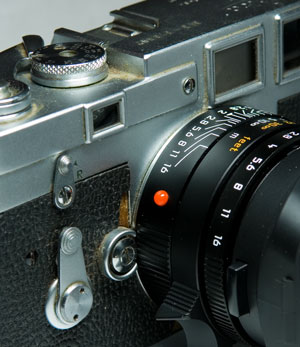2007-01-16

Here's a Leica M3, manufactured in 1955 and never CLAed ("cleaned, lubricated, and adjusted"), mated with a brand-new Leica 35mm Summicron lens. The contrast between the well-worn body and the new lens is striking.
I have the Leica on long-term loan (it belonged to my late brother-in-law, who bought it used in the mid-1960s). The lens, which just arrived, is supposed to go on a new M8 body whose arrival date is unknown. (I'm waiting along with a few hundred, or maybe thousand, other people.)
I was anxious to try out the lens, so I put it on the M3 (the fit was perfect), bought a roll of film (Kodak Ultra Color 100), and went out in the frigid afternoon air to try the combination out. I knew the M3 shutter had problems: It sticks at very low speeds, and fails to expose the whole frame at 1/1000. What speeds it uses for the other settings I have no idea, but they seemed reasonably close. Also, the double-stroke film advance requires a third partial stroke half the time to cock the shutter.
But the pictures were very sharp and, since I was bracketing, I had some well-exposed negatives to choose from. (My Panasonic Lumix DMC-LX2 served as a light meter.) Here's one shot scanned with my Minolta Scan Dual IV and then worked on just a little bit in Adobe Camera Raw, but not in Photoshop itself:

|
Click image for full-size picture. |
So how can the barely working Leica M3 take such a technically satisfactory picture? Simple: The M3 had very little to do with what got onto the film.
A rangefinder camera is a very simple device except for the rangefinder itself, which in a Leica, even an M3, is quite advanced. This M3's rangefinder and viewfinder are working almost perfectly, near as I can tell. True, the various prisms and lenses are scratched, dirty, and discolored, but they're not in the imaging optical path. There's no exposure meter, no swinging mirror, no automatic diaphragm. The problematic shutter, once opened, is out of the way, so there's an unobstructed path from the brand-new lens directly to the emulsion on the (also brand-new) film. The M3's body is nearly indestructible, and the camera doesn't appear to ever have been abused, so I'm pretty sure the film was flat and positioned where it was supposed to be.
So the pictures are as good as lens and film can make them. This M3 is annoying to operate, but it can take great pictures because it can mount that great lens. People who buy an expensive camera body and then put a cheap lens on it are doing things backwards!
These days I only want to shoot with digital cameras with built-in through-the-lens meters, so the M3, even if it does get that long-overdue CLA, won't get much use. I sure hope I can put that lens on an M8 soon!
One more thing: The picture of the Leica above and the one of the Argus the other day were both taken with my Nikon D200 SLR and its massive 17-55mm f/2.8 zoom, with about 2 minutes of setup. The D200 can run circles around a Leica, even an M8, when it comes to tricks like this.